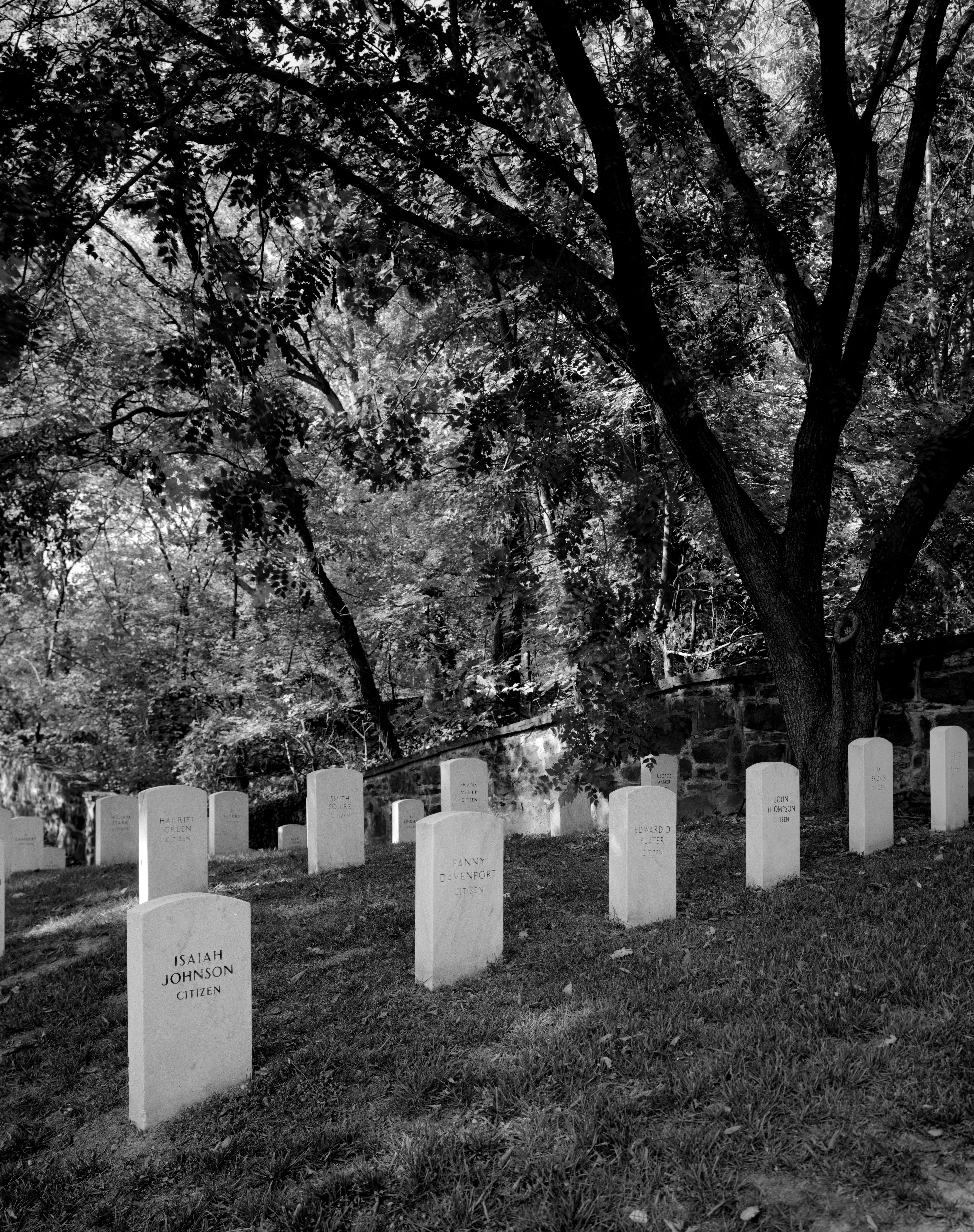By the time the sun darts across the Potomac River and casts Arlington House, the old Custis-Lee Mansion, in pink morning light, someone has already raised the flag on the hilltop to half-staff, signaling the start of another day at Arlington National Cemetery, where the first of more than two dozen funerals is about to begin.
A Navy marching platoon, resplendent in gleaming whites, moves down Meigs Drive, headed for a graveside service in Section 1; up at the Fort Myer stables, young soldiers in dress blues saddle up to pull a creaking caisson across the grassy hills for a ceremony at the Old Post Chapel; a half-mile away, six Marines in sharply pressed blue tunics and white trousers slow-march across the thick turf in Section 60, carrying a dead comrade on his last journey; overhead a squadron of Air Force fighters streaks across a blue sky in the missing man formation to honor another of the cemetery’s latest recruits. And so it goes throughout the day: Flags are folded into tight triangles; rifle salutes echo along the river; the pure notes of “Taps” drift amid the markers. At day’s end the visitors retreat, the flag comes down and the cemetery’s iron gates clang shut for the night.
Then silence descends over the 300,000 residents of the United States’ most hallowed ground, 624 acres of rolling Virginia countryside occupied by officers and enlisted men, presidents, Supreme Court justices, explorers, astronauts, former slaves and ordinary citizens who represent every conflict in which the nation has ever fought. For anyone who visits Arlington today, the prevailing impression is one of permanence and calm—in the neatly clipped grounds, the precisely spaced headstones and the clockwork precision of specialty platoons who send off comrades in a splendid flash of military style. So it is now, but there was little time for such niceties at the birth of Arlington National Cemetery, which has its origins as a potter’s field for Civil War soldiers and sailors.
Neither side had anticipated the war’s toll in blood, and bodies were piling up in Washington by the spring of 1864. Union Lt. Gen. Ulysses S. Grant had just launched his Overland Campaign against Confederate General Robert E. Lee; they fought a series of blistering battles across 70 miles of Virginia. By the time the campaign ended that June, Grant had lost 55,000 killed, wounded, captured or missing; Lee, 32,000. Wounded men filled Washington’s hospitals. Thousands died there. But there was no place to bury them. The national cemeteries at the Soldiers’ Home and in Alexandria, created by congressional action in 1862, had reached their combined capacity of 11,000 graves.
So in an act of improvisation—and with more than a touch of spite—Brig. Gen. Montgomery C. Meigs, the Union quartermaster general, began interring casualties at Arlington, the 1,100-acre estate owned by Mary Custis Lee, the wife of the Confederate commander. She had vacated the estate in May 1861 shortly after her husband declared for Virginia and went south. Because of Arlington’s strategic position overlooking the capital, Union forces quickly occupied the grounds, set up artillery positions and entrenchments and settled into camp there. They were joined in 1863 by hundreds of emancipated slaves, who made new homes in Freedman’s Village along the Potomac.
Since Federal forces already occupied the estate, and because Meigs considered Lee a traitor who deserved hanging, the Union quartermaster took the opportunity to further punish him by turning Arlington into a military graveyard. “I recommend…the land surrounding the Arlington Mansion, now understood to be the property of the United States, be appropriated as a National Cemetery,” Meigs wrote to Secretary of War Edwin M. Stanton on June 15, 1864. That same day Stanton signed the order to set aside the mansion and 200 surrounding acres for a Federal cemetery.
In truth, by the time of Meigs’ recommendation, nearly 30 soldiers were already buried at Arlington. The first to be buried there, on May 13, 1864, was 21-year-old Private William Christman of the 67th Pennsylvania Volunteer Infantry. Like most others claimed by the war, Christman was felled by disease instead of a bullet, dying of peritonitis in Washington’s Lincoln General Hospital. His grave, marked with a plain pine headboard, was soon joined by others of modest means, buried with no flags flying, no bands playing—and quite often with no chaplain present. With the nation fighting for its survival and the carnage mounting, the Army Quartermaster Corps could do little more than keep their shovels moving. There would be time later for ritual.
Once Stanton made Arlington’s designation official that June, Meigs visited the cemetery and was incensed to see that the graves of Christman and others had been placed well clear of the mansion on orders from Union officers billeted there. “On discovering this…I gave specific instructions to make the burials near the mansion,” Meigs recalled. He placed two rows of officers’ graves around Mrs. Lee’s rose garden. They remain there today. For good measure, Meigs ordered construction of a tomb amid the rose garden for the remains of 2,111 unknown soldiers. This mass grave, later capped by an ornate sarcophagus, would be Arlington’s first shrine to those who had lost not only their lives but also their identities in wartime.
Meigs’ placement of graves around the mansion was intended to make Arlington uninhabitable for the Lees—unless they wanted to live among the ghosts of the 15,000 dead who occupied the property by 1868. The family never did return.






